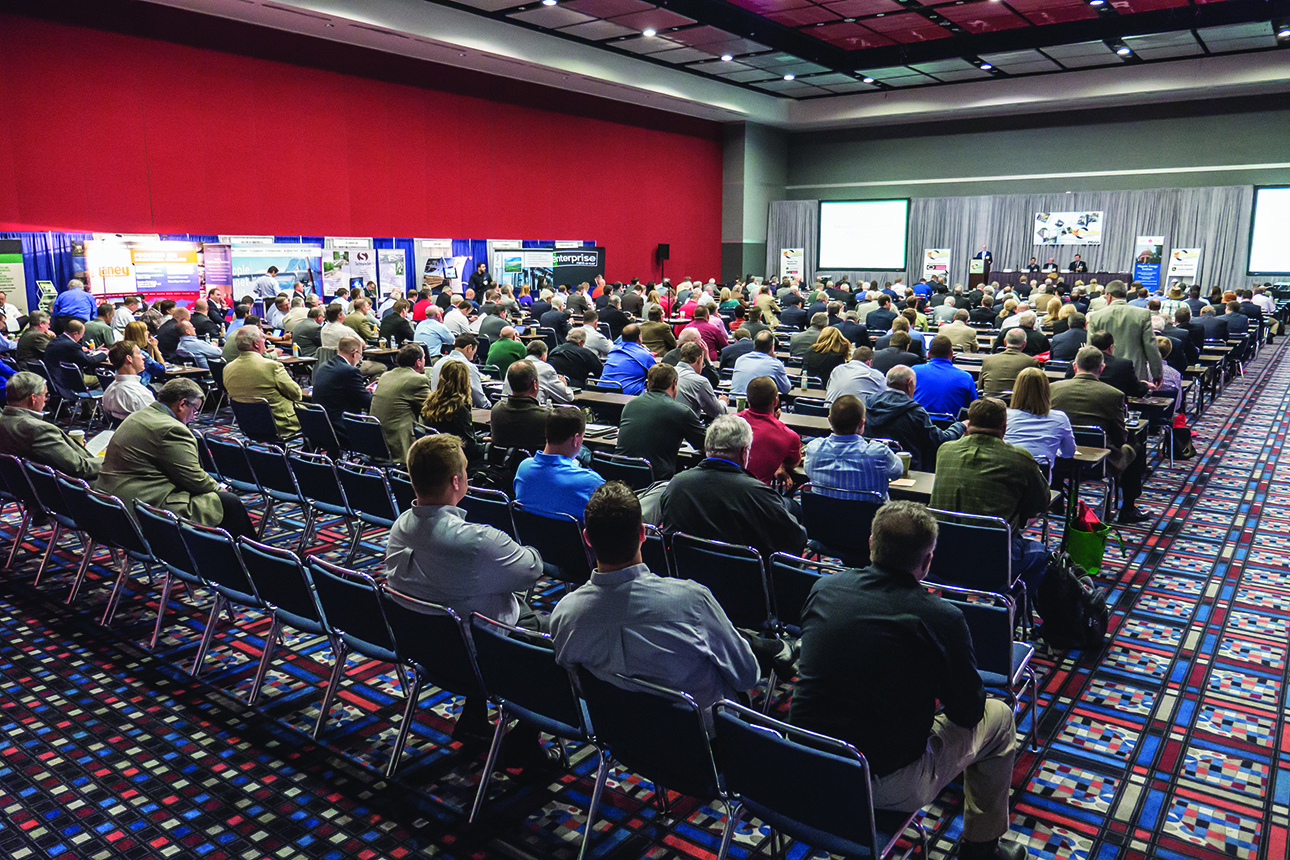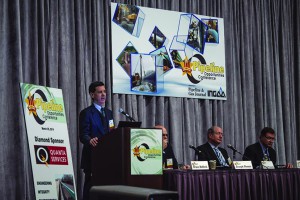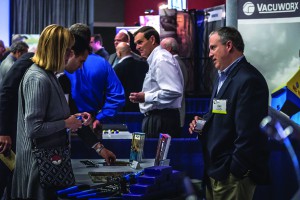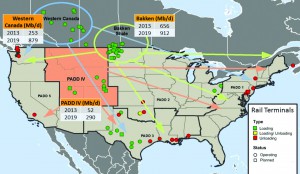June 2014, Vol. 241, No. 6
Features
Industry Leaders Predict Robust Pipeline Construction Market In Years Ahead

North America’s energy revolution is alive and well! That was the message at Pipeline & Gas Journal’s 10th annual Pipeline Opportunities Conference March 25 at the George R. Brown Convention Center in Houston. Issues covered included quality control for gas pipeline construction, the Pipeline Safety Act, prospects for infrastructure expansions to support new supply sources, the outlook for labor and employment and the benefits of working in an energy state like Texas.
Jeff Share, conference founder and organizer, said the single-day, near-sellout, drew nearly 500 attendees from throughout North America.
“The shale revolution has totally turned around the North American energy outlook and pipelines are every bit a part this, so much so that pipelines, for good and bad reasons, are constantly in the news,” Share said. “The factors affecting pipeline development are constantly evolving and it’s vital for us as an industry to be aware of any developments that can influence business decisions. Keystone, of course, is on everyone’s mind, and the implications that will result from President Obama’s final decision will be felt for years to come throughout the petroleum industry.”

In the first session, Bruce Bullock, director of the SMU Cox Maguire Energy Institute, provided a national economic outlook that focused on the nation’s recovery following the lengthy recession.
Calling the outlook “anemic at best,” Bullock said employment levels are just returning to where they were six years ago but total unemployment is at a 20-year high. He identified service, supply and refining as key trends negatively impacting the midstream sector and pointed out that proved reserve acquisition, finding and development and reserve replacement costs are all on the rise.
Next, Joseph R. Dancy, adjunct professor of energy and environmental law at SMU’s Dedman School of Law, overviewed major trends and opportunities in the energy sector including the massive boom in crude production in Texas and North Dakota. He said higher natural gas prices could be seen by summer and fall due to increased consumption and storage injections falling short.
Following, Gary Evans, chairman and CEO of Magnum Hunter, presented an outlook on the nation’s shale gas and oil production and reserve development in which he critiqued production figures for each of the shale play areas and cited ripple effects to the economy. He said the Bakken formation, which sits mostly in North Dakota, has led to record low unemployment.
He said weekly wages in North Dakota have risen 140% since 2001 and unemployment is less than 2%. Moreover, counties within 100 miles of the Bakken had the next largest increase in wages and the lowest unemployment.
Business economist Bernard Weinstein, associate director of the Maguire Energy Institute, offered an economic forecast for Texas and the Southwest. On oil and gas exports from the U.S., Weinstein said “we’re going to have to export gas,” though he noted that 30 LNG applications are pending with only seven approved. He said he does not expect the first crude exports from the U.S. until 2020.
In the following session, Carly Voight, quality management at GTS, focused on quality control and assurance for gas pipeline construction and practical tools to achieve a high level of performance.

Also, energy attorneys Catherine Little and Robert Hogfoss of Hunter and Williams LLP spoke on topics that included the Pipeline Safety Act, infrastructure expansion, regulatory compliance and environmental issues.
Keynote luncheon speaker Charles Nevle, manager, Energy Analysis BENTEK Energy, discussed the shale revolution and how it could be sustained. He focused on the nation’s growing energy production and demand as well as the challenges involved in building the infrastructure to handle the increasing production of crude oil, natural gas, NGLs and LPGs.
On the transport of crude oil by rail vs. pipeline, Nevle finds advantages to both modes of transport. “Rail projects are usually scoped out in terms of months while pipeline projects are scoped out in years,” he said. Nevle said railcar transport involves a much lower initial capital outlay compared to a pipeline project.
He said, “If you are a refinery on the West Coast looking to source feedstock by rail for your refinery, you have many options. You can look to the Bakken play, sourcing crude out of the oil sands of Canada, the Rockies or the Permian Basin.
“If you build a pipeline you’re simply marrying yourself to that option,” he said. “Also, considering the terrain to move crude to the West Coast market by pipeline can make rail a very attractive option.”
Nevle quickly stressed that does not mean pipelines are out. Instead, he called attention to the number of recent railcar accidents and said this could eventually bring about regulations that make railcar transport unattractive.

He also shared the accompanying slide showing railcar shipments totaling 2 MMbpd by 2016 and another depicting pipelines under construction, proposed and with firm commitment to carry Canadian and U.S. crude to coastal markets.
The start of the afternoon sessions focused on the Washington Report and an updated infrastructure study. Don Santa, president and CEO of the Interstate Natural Gas Association of America (INGAA), overviewed politics on Capitol Hill. INGAA Foundation Chairman Craig Meier provided information from the recently released report, North American Midstream Infrastructure through 2035: Capitalizing on Our Energy Abundance. The report, conducted by ICF International on behalf of the INGAA Foundation, updates a 2011 infrastructure report to reflect dynamic changes in the natural gas, NGL and crude oil industry in recent years.
In the final session, moderator Mack Mercer, vice president of T.G. Mercer Consulting Services Inc., posed questions to roundtable participants Charles Joyce, president Otis Eastern Service LLC., Tarry Hutton, director of operations, Henkels & McCoy Inc., Pipeline Division, Doug Evans, president and CEO, Gulf Interstate Engineering Co., Robert Bell, executive vice president, Price Gregory International Inc., and Mark Bridgers, principal, Continuum Advisory Group.

What is your company doing to address resource challenges and what impact has it had on your business?
Joyce: Certainly personnel are the first challenge. However, I feel that we’re in better shape than we have been at any other time in my career. Today, we’re able to plan, train and recruit some very good young minds to come into our business because we can forecast enough that lets them know they can have a future in this industry.
When you look at what the drilling industry has done by reducing the time it takes to drill a well, we can do something similar with construction. I feel the same on the equipment, development and technology side. So, I’m very upbeat.
Are there similar constraints on the engineering side as well?
Evans: On the engineering side we haven’t done a good job of selling this industry to the public or showing it as an attractive choice as a career path. Engineering is not an easy discipline and maybe we’re throwing it at our kids too early. We have a very high dropout rate and this is something we need to talk to the schools about.
From a practical side, we have to build up our staff, train and mentor these people ourselves. The good news is that we’re in a great industry we should all be proud of. Our quality is second to none of any industry in any part of the world.
Our safety is excellent but can always be improved. Equipment manufacturers, contractors and operators are all top notch. The message we need to get out is that our industry has a lot to offer and you don’t have to go to work for Google; come to work in the pipeline construction industry.
What is your outlook for the next several years?
Bell: The future does look bright and there are various attributes we can use to sell our industry although we haven’t done a real good job of that. It is also amazing how little people know, outside the industry, about what we do.
From a business standpoint, I look forward to the large volume of work that is out there and believe it is sustainable. The peaks and valleys will always be there, but maybe the valleys won’t be quite as low.
The volume of work we’re seeing is something we had no idea of even a year in advance. Some of these jobs are going out for bid in less than a year. This is particularly true in the midstream sector in the Northeast. It’s exciting to see the volume of work increasing and to be able to compete for it from both large and smaller companies.
Bridgers: The outlook is fantastic. We’ve already seen tremendous growth in this marketplace going back to 2000-2001. At the end of the day, barring some type of regulation that ends or dramatically curtails the use of hydraulic fracking as a technique to access shale oil and gas, the pipeline market and the crude, natural gas liquids and gas markets will be very robust.
Can you review a recent project that presented major challenges? Henkels & McCoy spent some time working on a project in the New York/New Jersey area for Spectra Energy.
Hutton: As you might imagine, any project in the Northeast, especially in New Jersey where you approach the metropolitan area, is challenging. We basically ran into everything you can think of, from having to filter the trench water to hauling off, manifesting and taking to a designated landfill every single spoonful of dirt that was taken out of the ground. Most of the pipeline, road and other utility crossings are 20+ feet deep which compounded the complexity of our project.
Bridgers: The challenges associated with infrastructure in the New England area are varied. Here is the greatest demand for energy resources and is where we might see construction of some of the manufacturing, cracking and various other types of facilities that would use natural gas liquids as a feed product. This also includes the conversion of coal-fired power facilities to burn gas.
All of that activity is going to be done in the Northeast to reduce the release of greenhouse gases and it will be the most expensive construction, on both the distribution and transmission side, once it takes place.
Some studies show that rail transportation is becoming more economical to a level approaching pipelines. How do you respond to that?
Evans: We heard earlier today how rail is quicker and possibly cheaper but I think we’ve discovered rail is no safer than transportation by pipelines. The rail side also has a very old infrastructure and they haven’t done as much as the pipeline industry to keep it up to date. For this reason, we should be able to compete with the rail side.
Part of the problem in getting pipelines built is the regulatory environment we face. If you’re involved in an interstate project and not crossing a state border, as opposed to a national border, you can get things done fairly quickly.
Bridgers: We are forecasting the construction of additional pipelines in the late teens and early 2020s that will replace the use of railcars to move some of the product. It will take several years to get those projects permitted and constructed. Once there is clarity that there won’t be regulations eliminating fracking there will be more incentive to build those longer term and ultimately cheaper and safer ways to transport fuel.
Bell: I often wonder what people in the pipeline industry think when they read or hear about a train wreck. I wonder if they see that as an incentive to build more pipelines. I’m worried that the publicity from train wrecks that result in oil or product spills heightens the awareness of people who are against any type of development or expansion of carbon-type infrastructure. I’m not sure it helps to point out the railcar industry’s safety record.
With the opposition to hydraulic fracking, do you see it changing and how much of an impact will it have on the pipeline sector?
Joyce: I happen to be from the state of New York and we’re a perfect example of what can happen when regulatory and political forces take over the process. There is a statewide moratorium on hydraulic fracturing which has trickled down to take the whole oil and gas exploration and production business out of play.
There are local town moratoriums, county moratoriums, and a statewide moratorium is under study. Local town boards, made up of four or five people, can pass a resolution that you can’t frack. Recently, Pennsylvania passed a resolution on zoning to site natural gas wells. We’ve seen Colorado and other states having problems as well.
This is something we’re all going to have to deal with. We’re going to have to show the big picture and the attributes of this industry to get people thinking globally about the industry. As an example, earlier this year we worked on a refinery project in Delaware to help build a facility to unload 90,000 bopd from railcars. All of the crude is sweet and light crude from North Dakota.
Two years ago, every barrel coming into that refinery was from dirty crude out of Ecuador. It had to be transported on tankers, pumped across the Panama Canal, put into tankers and transported to our sea coast and then trucked or piped on to its final destination.
We’re doing so much good and that’s the story we need to get out. Still, it will be an uphill battle.
What are some of the challenges facing the construction industry regarding safety?
Hutton: I think the industry is morphing into the safety environment. If you look back 30 years ago, the environmental movement had just started and it took 10-15 years to really gain some momentum. I believe that is where we are in terms of safety consciousness and awareness. You could also throw quality into that same basket. We’re at the infant stages of understanding how to translate safety from the management level down to the workers in the field. We’ve made huge strides in the last five to 10 years but we have a long way to go.
Bell: Safety is really important to our industry and it started with client companies asking the contractors to step up their game.
The biggest challenge is to try and teach all of our employees – starting from the crews all the way up to the engineering and superintendent levels – to take responsibility for not only themselves but for those with far less experience and safety training.
One problem is that young people coming into the business don’t always feel comfortable asking for help when they don’t know how to do something correctly or they see a task being performed that isn’t quite up to safety standards. We need to empower all of our employees so they will speak up when they see any type of safety violation.
What impact has the shale revolution had on the pipeline industry?
Bell: It’s made us change how we think about our industry. It wasn’t long ago we could name our traditional clients on two hands and they provided all the volume of work that sustained the construction industry. Now there are 15-20 midstream companies that do business in the Northeast alone, aside from the traditional large transmission companies. It is exciting and the shale play has driven us, starting with the Barnett, and it is not nearly over yet.
What are some of the major projects that might be on the horizon?
Bell: There are a number of projects on the horizon. Enbridge recently put the Southern Access project out for bid. This is a 30-inch pipeline to transport crude from Enbridge’s Flanagan Terminal near Pontiac, IL to an existing crude oil terminal near Patoka, IL.
Williams announced plans for the Southside Pipeline project in Virginia. This project involves 100 miles of 24-inch pipeline extending from the Transco mainline in Pittsylvania County terminating in Brunswick County.
Kinder Morgan Energy Partners LP plans to spend $1 billion to expand its carbon dioxide network with a new 213-mile pipeline. The Lobos Pipeline will transport carbon dioxide from the company’s St. Johns field in Apache County, AZ to its Cortez Pipeline in Torrance County, NM.
A project is under development by Sierrita Gas Pipeline LLC that is owned by Kinder Morgan Energy Partners for 60 miles of 36-inch natural gas pipeline between Tucson and Sasabe, AZ.
Williams and Boardwalk have partnered to develop the Bluegrass Pipeline to move gas liquids from the Marcellus and Utica shales in Pennsylvania, West Virginia and Ohio to the developing petrochemical market in the Northeast as well as the rapidly expanding petrochemical and export complex on the Gulf Coast.
There is also Keystone, of course. If we get a permit, work could start in 2015.





Comments